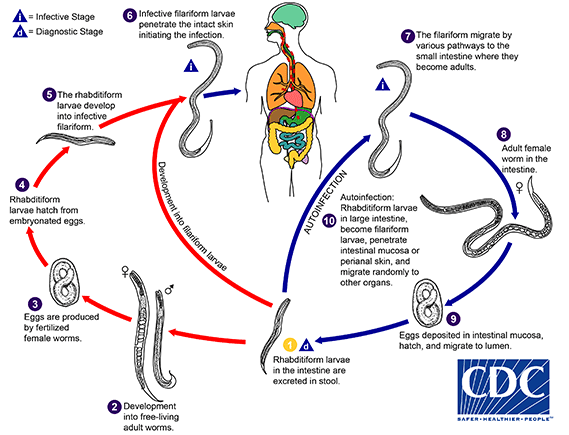Biology
Causal Agent
The nematode (roundworm) Strongyloides stercoralis. Other Strongyloides include S. fülleborni, which infects chimpanzees and baboons and may produce limited infections in humans.
Life Cycle

The Strongyloides life cycle is more complex than that of most nematodes with its alternation between free-living and parasitic cycles, and its potential for autoinfection and multiplication within the host. Two types of cycles exist: Free-living cycle: The rhabditiform larvae passed in the stool  (see "Parasitic cycle" below) can either become infective filariform larvae (direct development)
(see "Parasitic cycle" below) can either become infective filariform larvae (direct development)  or free living adult males and females
or free living adult males and females  that mate and produce eggs
that mate and produce eggs  from which rhabditiform larvae hatch
from which rhabditiform larvae hatch  . and eventually become infective filariform larvae
. and eventually become infective filariform larvae  . The filariform larvae penetrate the human host skin to initiate the parasitic cycle (see below)
. The filariform larvae penetrate the human host skin to initiate the parasitic cycle (see below)  . Parasitic cycle: Filariform larvae in contaminated soil penetrate the human skin
. Parasitic cycle: Filariform larvae in contaminated soil penetrate the human skin  , and by various, often random routes, migrate into the small intestine
, and by various, often random routes, migrate into the small intestine  . Historically it was believed that the L3 larvae migrate via the bloodstream to the lungs, where they are eventually coughed up and swallowed. However, there is also evidence that L3 larvae can migrate directly to the intestine via connective tissues. In the small intestine they molt twice and become adult female worms
. Historically it was believed that the L3 larvae migrate via the bloodstream to the lungs, where they are eventually coughed up and swallowed. However, there is also evidence that L3 larvae can migrate directly to the intestine via connective tissues. In the small intestine they molt twice and become adult female worms  . The females live threaded in the epithelium of the small intestine and by parthenogenesis produce eggs
. The females live threaded in the epithelium of the small intestine and by parthenogenesis produce eggs  , which yield rhabditiform larvae. The rhabditiform larvae can either be passed in the stool
, which yield rhabditiform larvae. The rhabditiform larvae can either be passed in the stool  (see "Free-living cycle" above), or can cause autoinfection
(see "Free-living cycle" above), or can cause autoinfection  . In autoinfection, the rhabditiform larvae become infective filariform larvae, which can penetrate either the intestinal mucosa (internal autoinfection) or the skin of the perianal area (external autoinfection); in either case, the filariform larvae may disseminate throughout the body. To date, occurrence of autoinfection in humans with helminthic infections is recognized only in Strongyloides stercoralis and Capillaria philippinensis infections. In the case of Strongyloides, autoinfection may explain the possibility of persistent infections for many years in persons who have not been in an endemic area and of hyperinfections in immunosuppressed individuals.
. In autoinfection, the rhabditiform larvae become infective filariform larvae, which can penetrate either the intestinal mucosa (internal autoinfection) or the skin of the perianal area (external autoinfection); in either case, the filariform larvae may disseminate throughout the body. To date, occurrence of autoinfection in humans with helminthic infections is recognized only in Strongyloides stercoralis and Capillaria philippinensis infections. In the case of Strongyloides, autoinfection may explain the possibility of persistent infections for many years in persons who have not been in an endemic area and of hyperinfections in immunosuppressed individuals.
Life cycle image and information courtesy of DPDx.
- Page last reviewed: April 13, 2015
- Page last updated: April 13, 2015
- Content source:


 ShareCompartir
ShareCompartir